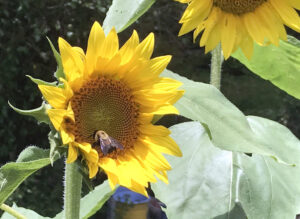A version of this column first ran in the Roane County (WV) Reporter and Times Record. Support local journalism! Subscribe to your local newspaper.
 As we move into late fall, and soon, early winter—I see snow in the forecast!—there isn’t much to do in the garden. But that makes it a good time to curl up in a cozy chair with some seed catalogs, dreaming of next year’s garden. Or with garden books, learning about better ways to garden as well as the science of soil.
As we move into late fall, and soon, early winter—I see snow in the forecast!—there isn’t much to do in the garden. But that makes it a good time to curl up in a cozy chair with some seed catalogs, dreaming of next year’s garden. Or with garden books, learning about better ways to garden as well as the science of soil.
Unfortunately it isn’t easy to get books with libraries closed, but some libraries are still lending some e-books online—and of course, if you’re willing to pay for them you can get all kinds of books sent to you, and you can keep them for reference later.
I’m going to talk about my favorite gardening books here.
My number one favorite I have unfortunately lost; I don’t remember who I last lent it to so I likely will never get it back. It’s Cindy Conner’s Grow a Sustainable Diet. This is my favorite because Conner lives in central Virginia, where conditions are quite similar to here, and her objectives are much like mine. She aims to grow as much as possible of her household’s food, without depleting the soil or needing to bring in fertility from elsewhere. Her system is much like mine; she has chickens and some other livestock but the book concentrates on a large well-fenced garden with permanent raised beds. She says the secret is to have 60% of your bed-months in cover crops, raised not to eat but to feed the soil. This would take way too much away from growing your own food, except that much of the cover cropping can be over the winter. You multiply the number of beds by twelve months; if all the beds have cover crops through the five months in which we don’t typically have much in gardens—and then some beds won’t get planted until May, or will have their crops harvested in September—that gives you close to 50%. She keeps one bed in compost too.
I don’t do that, my compost is elsewhere, but I do cover a lot of beds with cover crops these days, and the ones I don’t manage that, I cover with hay so at least they’re not bare all winter.
Conner’s book is full of information about which crops supply the most important nutrients, how to get the most out of your beds by planning tight crop rotations, and companion planting. She also talks about flour milling, oil pressing and solar drying of garden produce, and has a picture section to illustrate.
Carol Deppe’s The Resilient Gardener—which I know the Spencer, WV library has—is similarly focused on how to feed yourself in uncertain times with a large garden. Her circumstances are very different from mine, so a lot of the book is not useful to me but it still is full of good stuff and so well written. It also has a picture section. What’s different is that she has celiac disease and must not eat wheat, rye or anything related, and so she uses corn for bread, and goes into quite a bit of detail about that; she also has a bad back and chooses her tools and practices to minimize back strain.
The other reason her book isn’t such a great fit is that she lives in Oregon, where they get 60 inches of rain a year, but all of it comes between November and April or May—so irrigation is a major topic. Her growing season is similar to ours but the winters are milder and the summers cooler and cloudier. This affects all kinds of things like choice of crops and varieties—but the book still has quite a bit of useful information, particularly about the five staple crops she focuses on: corn, beans, squash, potatoes, and duck eggs.
If you want to go for full self-sufficiency you’ll want try your hand at growing grains, and the book on this subject is Gene Logsdon’s Small Scale Grain Growing. He has chapters on each grain, full of information and lots of humor. I have this book, and have tried growing wheat, rye and oats but so far my success has been limited. He says—as do all the other books that address the subject—that corn is by far the easiest, both to grow and to process. It has been most successful for me—along with sunflower seeds (for chicken feed) which he doesn’t cover.
Rodale Press has put out many useful books on aspects of gardening. Elliot Cole writes books about four-season gardening, using unheated tunnels; he lives in cold Maine. Michael Pollan wrote a book called Second Nature before he wrote the ones that made him famous—it’s just as fascinating as his other books. John Jeavon’s How to Grow More Vegetables (that’s not even half the title but that’s enough) details the biointensive approach to getting a lot of vegetables out of a small plot—I am not excited about double digging (setting the dirt aside to dig another spade depth, then eventually putting all the dirt back) and he is located on the chilly but never cold California coast—but nonetheless there is good info there. Also: many of these gardeners, and others, have blogs, so you can find some good winter reading to chow down on, even if it isn’t easy to acquire books. May this hold you until you can get your hands in the holy dirt in March!
Use the comment section for questions, objections and suggestions.
